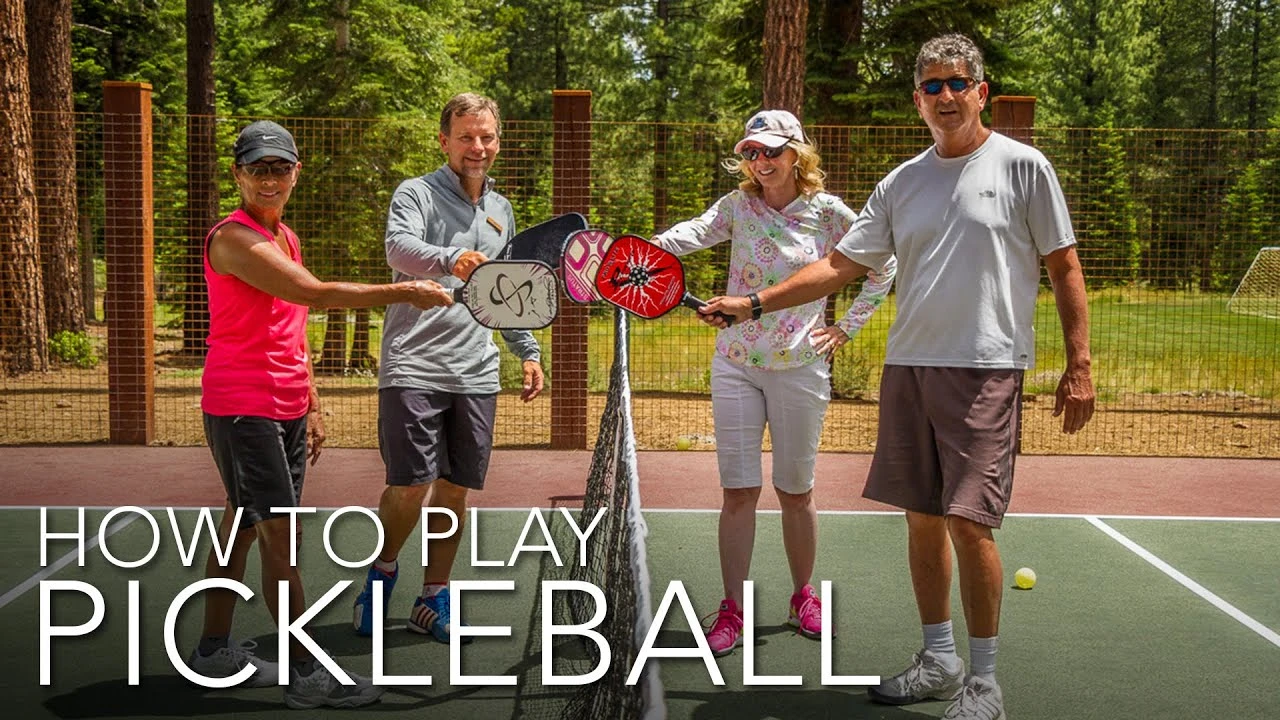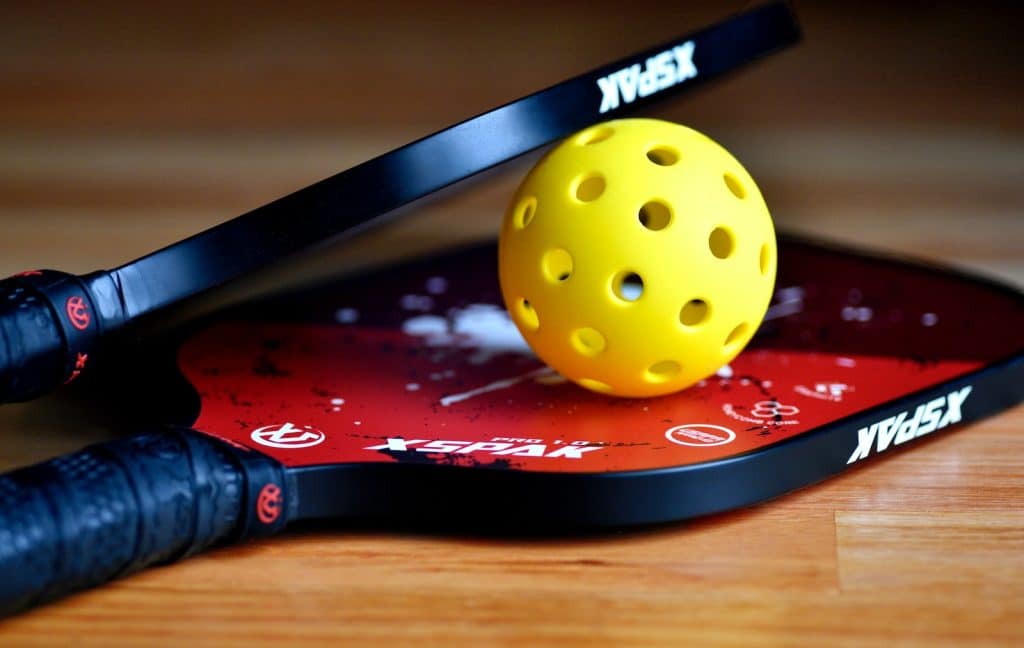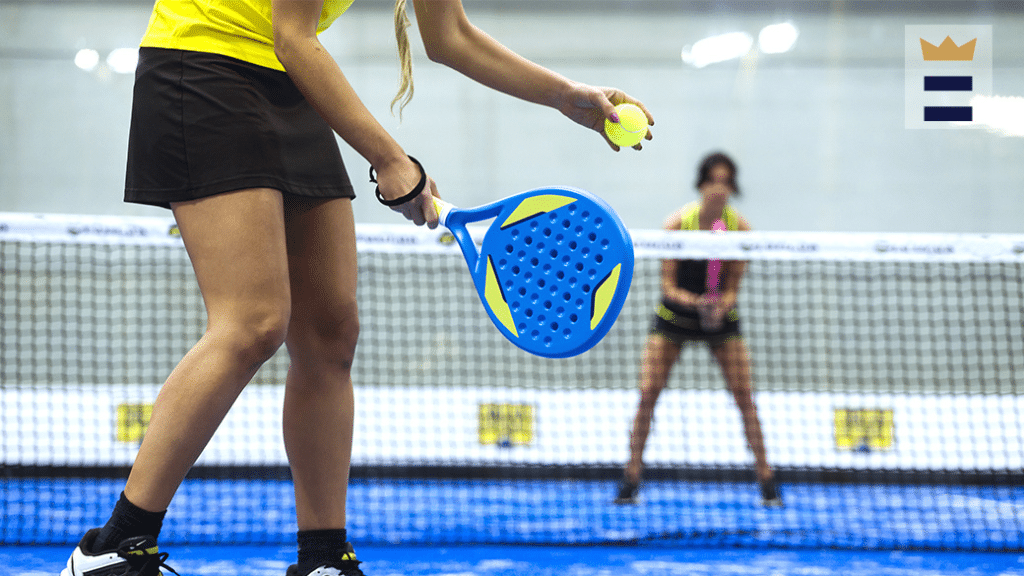Pickleball is a fun, social sport that combines elements of tennis, badminton, and table tennis. It is played on a badminton-sized court with paddles and a plastic ball with holes like a wiffle ball.
The pickleball game can be played as singles or doubles. The court measures 20×44 feet, which is approximately a quarter the size of a tennis court. The net is hung at 36 inches on the ends and 34 inches in the middle.
The basic premise of pickleball is to hit the ball diagonally across the net and cause the opposing team to miss the return. Points are only scored by the serving team.
This beginner’s guide covers the basic rules of how to play pickleball, scoring, serving, and gameplay to help you learn how to play pickleball.
Here are the basic pickleball rules:
- Games are usually played doubles, to 11 points, win by 2. The serve must be underhand and hit diagonally cross court. Only one serve attempt is allowed.
- In addition to playing with two people on each team, you can also play pickleball with just one person on each side of the net. Keep in mind that how you play singles might be a bit different from doubles.
- To decide who serves first, you can simply flip a coin. This makes sure the game starts fairly for both teams.
- Normally, a game ends when one side gets 11 points or more, as long as they’re ahead by at least 2 points. This means the game is over, and the team or player with a lead of at least 2 points wins.
- After the serve, the ball must bounce before being returned. Then the serving team must let it bounce before hitting it back (the “two bounce rule”). After that, volleying or playing the ball off a bounce is allowed.
- There is a “no volley zone” called the kitchen near the net. Players cannot volley when standing in this zone.
- Scoring uses a “side out” system where each side serves until they commit a fault. In doubles, partners alternate serving turns. Both players on the serving doubles team have the opportunity to serve and score points until they commit a fault.
Table of Contents
- 1 Equipment Needed to Play Pickleball
- 2 Rules of Pickleball
- 2.1 Rule 1 – The Serve
- 2.2 Rule 2 – Underhand Serve
- 2.3 Rule 3 – Continue Point Until Fault
- 2.4 Rule 4 – No Volleying in Kitchen
- 2.5 Rule 5 – Can Hit Groundstrokes in Kitchen
- 2.6 Rule 6 – Double Bounce Rule
- 2.7 Rule 7 – Only Score on Serve
- 2.8 Rule 8 – Both Partners Serve
- 2.9 Rule 9 – First to 11 Points, Win by 2
- 3 Pickleball Gameplay Basics
- 4 How to Serve in Pickleball
- 5 How to Start a Pickleball Game
- 6 How to Play Pickleball Singles
- 7 How to Play Pickleball Doubles
- 8 Scoring in Pickleball
- 9 Faults in Pickleball
- 10 Where to Find Pickleball Courts
- 11 Indoor vs. Outdoor Pickleball
- 12 Joining Pickleball Leagues and Clubs
Equipment Needed to Play Pickleball
To play pickleball you’ll need:
- Pickleball paddle – The paddle has a long handle and a solid face similar to a racquetball racquet. Paddles come in a variety of materials like aluminum, graphite, composite, or wood. Paddle materials like aluminum, composite, graphite, wood all have different attributes. Composite paddles offer a nice balance. Consider grip size and paddle weight based on your hand size and strength.
- Pickleball – The ball is made of plastic with holes all over it like a wiffle ball. This allows the ball to move slower than a tennis ball. Balls range from indoor versions to outdoor balls optimized for concrete or asphalt courts.
- Comfortable athletic clothing – Anything easy to move in like t-shirts, shorts, activewear.
- Athletic court shoes – Shoes designed for racket sports like tennis shoes work well for traction and support.
Many rec centers and parks will have paddles and balls available to borrow or rent. But serious players often buy their own higher quality equipment.
Rules of Pickleball
Pickleball has some unique rules that differentiate it from other racket sports. Learning these basic rules will help you follow gameplay as a beginner.
Rule 1 – The Serve
One player starts the game by serving the ball diagonally across the pickleball court into the service court. The serve must clear the non-volley zone line to count. Only the serving team can score points.
Rule 2 – Underhand Serve
The serve must be made underhand below waist level in one smooth, upward arcing motion, and only one serve attempt is allowed per server. Most players serve the ball in the air but you can also do a “drop serve” after bouncing the ball first.
Rule 3 – Continue Point Until Fault
After the serve, players alternate hitting the ball across the net until one team commits a fault. A fault ends the rally and stops play. Common faults include hitting the ball out of bounds, into the net, or violating a rule like the two bounce rule.
Rule 4 – No Volleying in Kitchen
The non-volley zone (NVZ), commonly referred to as the “kitchen”, is a 7-foot area next to the net where players cannot volley the ball. You must let the ball bounce before hitting it inside the kitchen.
Rule 5 – Can Hit Groundstrokes in Kitchen
You are allowed to enter the kitchen area to hit a groundstroke after the ball has bounced. But you cannot be touching the non volley zone line while striking the ball.
Rule 6 – Double Bounce Rule
Before volleying the ball, it must bounce once on each side. So the serving team must let the return bounce before volleying. This rule prevents the serving team from immediately rushing the net.
Rule 7 – Only Score on Serve
In pickleball, only the serving team can score points. The other team can only gain the serve once the serving team commits a fault and loses the rally.
Rule 8 – Both Partners Serve
In doubles, each player on the serving team gets the chance to serve following the service sequence. The first server serves until their team loses a rally. Then the second partner serves.
Rule 9 – First to 11 Points, Win by 2
Games are played to 11 points, but you must win by 2 points. So if the score is 10-10, play continues until one team pulls ahead by 2 points like 11-10 or 12-10.
Pickleball Gameplay Basics
Pickleball rallies involve alternating groundstrokes and volleys. Common shots include:
- Forehand – Hit with palm facing toward the direction of the shot
- Backhand – Hit with palm facing away from the shot
- Volley – Hitting the ball out of the air without a bounce
- Lob – Hitting the ball high in the air over opponent’s heads
- Dink – A soft shot landing close to the non-volley zone
Strategies like keeping volleys low, hitting to opponent’s feet on dinks, and controlling the center line can help beginners win more points.
How to Serve in Pickleball
Executing the serve is an important skill to develop as a beginner pickleball player. Here are serving basics:
Where to Serve
The serve must be made from behind the baseline into the diagonally opposite service court. The ball should clear the non-volley zone line to count.
Where to Stand
The server must have at least one foot behind the baseline when initiating the serve. Do not step over the line until after the ball is struck.
Serving Strategies
While the serve is not an offensive weapon like in tennis, you can use it strategically:
- Aim deep to force opponents back
- Keep the serve low to increase errors
- Vary speed, placement, and spin
How to Start a Pickleball Game
To start a pickleball game:
- Use a coin flip or other fair method to determine which team serves first.
- The starting server stands on the right side and serves diagonally.
- The starting score is called out as “0-0-2” with the “2” indicating this is the first server.
- The first server continues serving until their team loses a rally and commits a fault.
How to Play Pickleball Singles
The rules and scoring are similar in singles play with a few key differences:
- Only one player per side instead of teams
- The server’s score is called first when announcing the score
- The server switches sides after winning a point
- When the server loses the rally, a side out occurs
In singles after a side out, the server alternates serving from the right and left side based on their score. Even numbers they serve from the right, odd numbers they serve from left.
How to Play Pickleball Doubles
In doubles pickleball:
- There are two players per team who stand on opposite sides of the court
- Partners serve in sequence, alternating each side out
- Scoring is called out as “ServerScore-OpponentScore-ServerNumber”
- Communication between partners is key
The serving team players should start each point at the baseline due to the two bounce rule. The receiving team partner not receiving the serve should start at the non-volley line.
Scoring in Pickleball
The pickleball scoring system involves calling out three numbers:
- The first number is the serving team’s score
- The second is the opposing team’s score
- The third number is 1 or 2 denoting which server is up
So a sample score could be “4-2-1” meaning the serving team has 4 points, the opposing team has 2 points, and the serving team’s first partner is currently serving.
Games are played to 11 points, but a team must win by 2 points.
Faults in Pickleball
Remember these key rules:
- If the ball touches any part of the kitchen (non-volley zone) during the serve, including the line, it’s a fault.
- Hitting the ball out of bounds or failing to clear the net is also a fault.
- Avoid volleying in the kitchen.
- Follow the two bounce rule: don’t volley the ball before it has bounced twice on each side of the net.
Where to Find Pickleball Courts
Looking to start playing? Here are some places to find pickleball courts near you:
- Local community centers, YMCAs, parks
- Tennis facilities & country clubs
- Schools and community colleges
- Online court finder maps
Many areas now have dedicated pickleball courts due to its rising popularity. You can also convert a tennis court using portable nets and pickleball court lines.
Indoor vs. Outdoor Pickleball
Indoor courts are ideal for year-round play. Strategies change slightly on an indoor court:
- Games move faster given the confined space
- No wind or sun elements to account for
- Balls designed for indoor courts have less bounce
Outdoor courts provide nice scenery and fresh air. Just be sure to bring sunscreen!
Joining Pickleball Leagues and Clubs
To find active players in your area:
- Search for a local pickleball meetup group through Meetup.com
- Check websites and social media for pickleball clubs
- Visit pickleballtournaments.com to find local tournaments
- Introduce friends and family to the game
Conclusion
Pickleball combines simple rules and fast-paced volley rallies to create a fun game for all ages and abilities. With just a net, paddles, and a ball you can get started playing this popular sport. Use this beginner’s guide to help you learn the basics of serving, scoring, and gameplay strategy.



